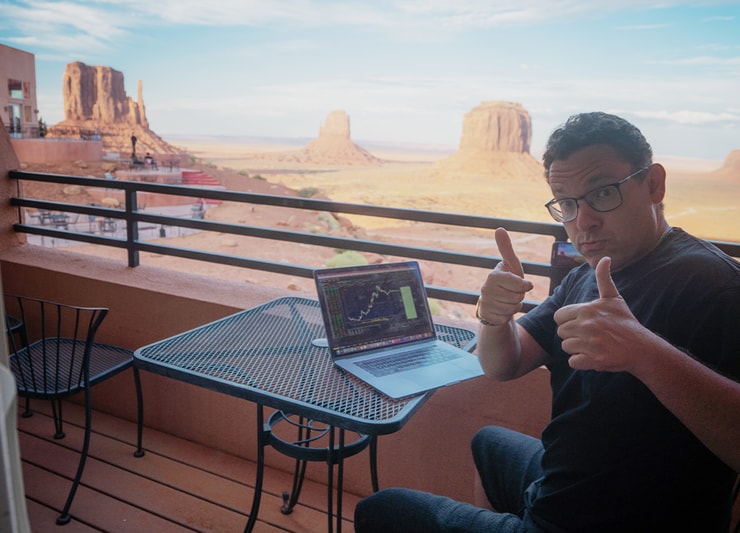Trading is not just a game…
It’s a psychological battle against the market– and yourself.
Trusting the process is vital…yet often elusive.
Patience is your companion, the quiet force guiding you to wait for the right moment.
Logically, it makes sense.
However, we have this incredible urge inside us to go out and trade, and try to make something happen. We sometimes want to make money so bad…that we force trades.
Which usually ends with pain and regret.
Remember LIFW’s wild ride from $3.05 to $17.48?
Sure…it was an epic short squeeze. But what if I told you there was a cleaner trade, more calculated, and incredibly lucrative?
I’ll show what that trade was, how it was responsible for one of my best trading days of the year, and how you can potentially take advantage of this recurring setup.
Table of Contents
One Of My Best Days…Despite Difficult Conditions

2025 Millionaire Media, LLCBelieve it or not…some of my best trading days occur when I’m jet lagged and sleep deprived.
Monday was no different.
If you’ve been following me on social media then you know I’m in Japan right now.
Not only did I get a chance to meet up with one of my first millionaire students, Michael Goode…
But I got an opportunity to meet up with my inner circle student Cameron and his wife…
If you haven’t heard about my inner circle yet, you can learn more about it here.
So yeah…I haven’t gotten tons of sleep…but that actually works in my favor.
Why?
Because I’m not in a rush to trade.
Moreover, it allows me to focus and wait for the absolute best setups to trade.
And that’s what happened on Monday.
Was This A Cleaner Trade Than LIFW?

2025 Millionaire Media, LLCI actually didn’t trade LIFW on Monday…however I did have it on my radar.
In fact, days before the epic short squeeze, I made an entire video about it.
It rallied by more than 1,000% from when I first got in earlier in the month.
More Breaking News
- HIVE Stock Surges: What’s Next?
- Cipher Mining’s Bitcoin Boost: Buying Opportunity?
- Is SoundHound AI Stock Ready for Takeoff?
But despite not trading it on Monday…I was able to get in on the action via a sympathy play.
What Is A Sympathy Play

2025 Millionaire Media, LLCA “sympathy play” is a term for stocks that catch the momentum of a leading stock within their sector or sharing key traits.
These “sympathy” stocks often trend alongside the primary mover, reflecting sector-wide investor sentiment.
Take the meme stock mania of 2020: one stock’s gain would typically buoy others in its wake, demonstrating the phenomenon. In the crypto stock rally of 2021, a single stock’s positive news could trigger a widespread surge.
While this dynamic affects both positive and negative news, the initiating stock usually experiences more intense volatility compared to its sympathetically moving counterparts.
So what was the sympathy play for LIFW?
Was CANO A Better Play Than LIFW?

2025 Millionaire Media, LLCI traded the ticker symbol CANO twice on Monday…making solid gains each time.
Why did I trade it?
Because I got a StocksToTrade Breaking News alert… It turned out that CANO had a 60% stake in LIFW. In other words, the higher LIFW went up…we should see some upwards movement in CANO.
And that’s exactly what happened.
I got a chance to trade it on a panic dip buy again…
Source: etrade
At one point the stock was up over 50%…
Now, I didn’t nail the entries or exits…
But when a stock makes such an impressive move…you don’t have to be perfect to profit.
And you know what else?
Traders are constantly looking for sympathy plays.
Why?
Because if something recently worked…they are trying to replicate that success.
They’re always trying to find connections and take advantage of similar situations.
That’s why I’m constantly telling my students to study hard.
Ready to Uncover the Psychology Behind the Trade? 🧠

2025 Millionaire Media, LLCThe trading world is more than just numbers and charts; it’s a mental arena where patience and strategy reign supreme.
Remember the wild LIFW rally from $3.05 to $17.48? That wasn’t just luck—it was a psychological mastery and a perfect demonstration of timing and market sentiment understanding. 🚀
🔥 What if you could spot a “cleaner,” more calculated trade, just like the CANO play I mastered for a massive win, even under sleep-deprived conditions?
🔥 What if you could learn to harness the power of sympathy plays, riding the waves of market momentum for your gain?
📉 Too many traders force the action, resulting in loss and regret.
But you can shift the odds in your favor by learning to wait for the right moment, just like I do, even when every fiber of your being urges you to trade.
👀 Join us for our next live training where I’ll break down my trades, reveal the secrets behind successful sympathy plays, and show you how to patiently pull the trigger on trades with the highest potential.
🚀 Gain exclusive insights into actionable strategies that work in today’s complex market.
🚀 Watch over my shoulder as I analyze the market in real time and teach you to profit from the psychological battles of trading.
Are you ready to learn the art of patience and strategy in trading?
To capitalize on market movements and develop a mental edge over the competition? Your chance to be part of my inner circle of traders is just a click away.
Take the next step in your trading journey. Learn the ropes of winning psychological warfare in the markets. Your spot at my live training is waiting. 📈











Leave a reply